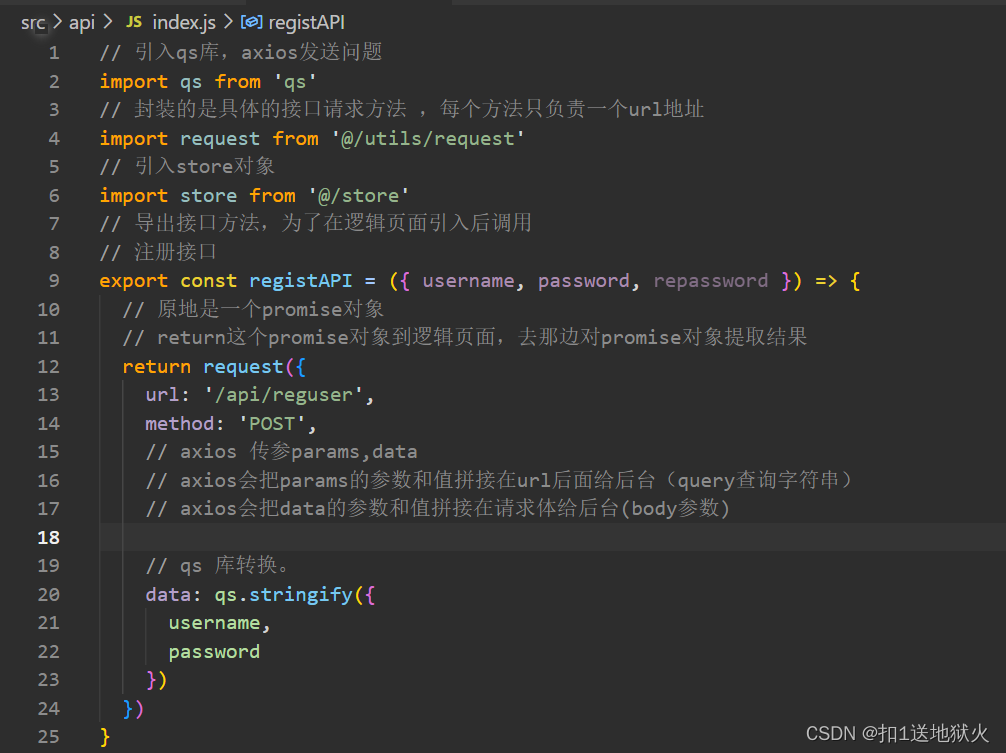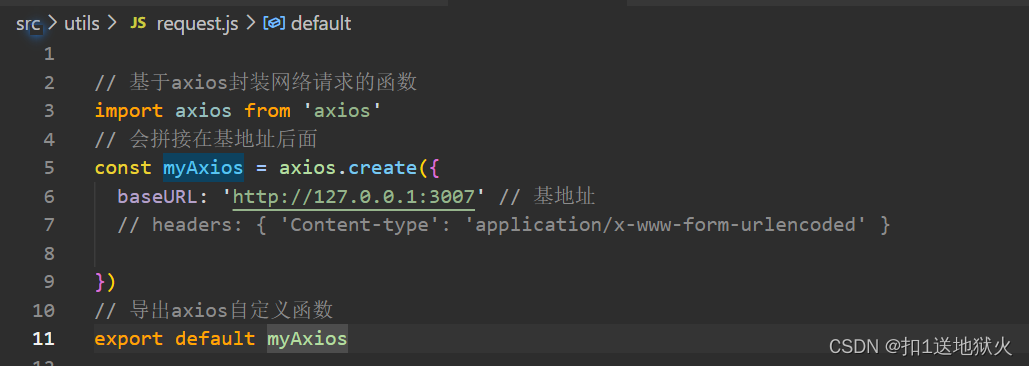文章基于尚硅谷
HTTP
1. 前后台交互的基本过程

1. 前后应用从浏览器端向服务器发送HTTP请求(请求报文)
2. 后台服务器接收到请求后, 调度服务器应用处理请求, 向浏览器端返回HTTP响应(响应报文)
3. 浏览器端接收到响应, 解析显示响应体/调用监视回调
HTTP请求报文
请求行:
请求方式/url
常用请求方式get post delete put
POST /login
多个请求头
Host: www.baidu.com
Cookie: BAIDUID=AD3B0FA706E; BIDUPSID=AD3B0FA706;
Content-Type: application/x-www-form-urlencoded 或者application/json
请求体
username=tom&pwd=123 urlencoded
{"username": "tom", "pwd": 123} json
HTTP 响应报文
响应状态行:
status
statusText
多个响应头
Content-Type: text/html;charset=utf-8
Set-Cookie: BD_CK_SAM=1;path=/
响应体
html 文本/json 文本/js/css/图片...
post 请求体参数格式
1.Content-Type: application/x-www-form-urlencoded;charset=utf-8
用于键值对参数,参数的键值用=连接, 参数之间用&连接
例如: name=%E5%B0%8F%E6%98%8E&age=12
2.Content-Type: application/json;charset=utf-8
用于 json 字符串参数
例如: {"name": "%E5%B0%8F%E6%98%8E", "age": 12}
3.Content-Type: multipart/form-data
用于文件上传请求
常见的响应状态码
200 OK 请求成功。一般用于GET与POST请求
201 Created 已创建。成功请求并创建了新的资源
401 Unauthorized 未授权/请求要求用户的身份认证
404 Not Found 服务器无法根据客户端的请求找到资源
500 Internal Server Error 服务器内部错误,无法完成请求
不同类型的请求及其作用
1. GET: 从服务器端读取数据
2. POST: 向服务器端添加新数据
3. PUT: 更新服务器端已经数据
4. DELETE: 删除服务器端数据API 的分类
REST API: restful (Representational State Transfer (资源)表现层状态转化)
(1) 发送请求进行CRUD 哪个操作由请求方式来决定
(2) 同一个请求路径可以进行多个操作
(3) 请求方式会用到GET/POST/PUT/DELETE
非REST API: restless
(1) 请求方式不决定请求的CRUD 操作
(2) 一个请求路径只对应一个操作
(3) 一般只有GET/POST
测试: 可以使用json-server快速搭建模拟的rest api 接口
2.json-server使用
npm install -g json-server目标根目录下创建数据库 json 文件:db.json
{
"posts": [
{ "id": 1, "title": "json-server", "author": "typicode" },
{ "id": 2, "title": "json-server2", "author": "typicode" }
],
"comments": [
{ "id": 1, "body": "some comment", "postId": 1 }
],
"profile": { "name": "typicode" }
}
启动服务器执行命令
json-server --watch db.json3 xhr的理解和使用
区别一般 http 请求与 ajax 请求
xhrAPI
- 1. XMLHttpRequest(): 创建 XHR 对象的构造函数
- 2. status: 响应状态码值, 比如 200, 404
- 3. statusText: 响应状态文本
- 4. readyState: 标识请求状态的只读属性
- 5. onreadystatechange: 绑定 readyState 改变的监听
- 6. responseType: 指定响应数据类型, 如果是'json', 得到响应后自动解析响应体数据
- 7. response: 响应体数据, 类型取决于 responseType 的指定
- 8. timeout: 指定请求超时时间, 默认为 0 代表没有限制
- 9. ontimeout: 绑定超时的监听
- 10. onerror: 绑定请求网络错误的监听
- 11. open(): 初始化一个请求, 参数为: (method, url[, async])
- 12. send(data): 发送请求
- 13. abort(): 中断请求
- 14. getResponseHeader(name): 获取指定名称的响应头值
- 15. getAllResponseHeaders(): 获取所有响应头组成的字符串
- 16. setRequestHeader(name, value): 设置请求头
4 使用XHR 封装一个简单版axios
axios特点
- 函数的返回值为
promise, 成功的结果为response, 失败的结果为error - 能处理多种类型的请求: GET/POST/PUT/DELETE
- 函数的参数为一个配置对象
{ url: '', // 请求地址 method: '', // 请求方式GET/POST/PUT/DELETE params: {}, // GET/DELETE 请求的 query 参数 data: {}, // POST/PUT 请求的请求体参数 } - 响应 json数据 自动解析为 js的对象/数组
简单axios编码实现
function axios({
url,
methed = 'GET',
params = {},
data = {}
}) {
//返回一个premise对象
return new Promise((resolve, reject) => {
// 执行异步Ajax请求
//处理method(转为大写)
methed = methed.toUpperCase()
/*
{
id: 1,
xxx:'abc'
}
*/
//处理query参数(拼接到url上) id=1&xxx=abc
let queryString = ''
Object.keys(params).forEach(key => {
queryString += `${key}=${params[key]}&`
})
if (queryString) {//id=1&xxx=abc&
//去除最后的&
queryString = queryString.substring(0, queryString.length - 1)
//拼接到url上
url += '?' + queryString
}
//创建xhr对象
const request = new XMLHttpRequest()
//打开连接(初始化请求)
request.open(methed, url, true)
//绑定状态改变的监听
request.onreadystatechange = function () {
//如果请求没有完成,直接结束
if (request.readyState !== 4) {
return
}
//如果响应状态码在200到299之间代表成功 否则失败
const { status, statusText } = request
//如果请求成功调用resolve()
if (status >= 200 & status <= 299) {
//准备结果对象
const response = {
data: JSON.parse(request.response),//响应json数据自动解析为js的对象/数组
status,
statusText
}
resolve(response)
} else {//如果请求失败调用reject()
reject(new Error('request error status is ' + status))
}
}
//发送请求
if (methed === 'GET' || methed === 'DELETE') {
request.send()
} else if (methed === 'POST' || methed === 'PUT') {
request.setRequestHeader('Content-Type', 'application/json;charset=utf-8')//告诉服务器请求体的格式是json
request.send(JSON.stringify(data))//发送json格式请求体参数 send异步
}
})
}使用测试
// 1. GET请求:从服务器端获取数据
function testGet() {
axios({
url: 'http://localhost:3000/posts',
method: 'GET',
params:{
id: 1,
xxx: 'abc'
}
}).then(
response => {
console.log(response)
},
error => {
alert(error.message)
}
)
}
// 2. POST请求:向服务器端添加数据
function testPost() {
axios({
url: 'http://localhost:3000/posts',
method: 'POST',
data: {
"title": "json-server_post",
"author": "typicode_post"
}
}).then(
response => {
console.log(response)
},
error => {
alert(error.message)
}
)
}
// 3. PUT请求:服务器更新数据
function testPut() {
axios({
url: 'http://localhost:3000/posts/1',
method: 'PUT',
data: {
"title": "json-server_put",
"author": "typicode_put"
}
}).then(
response => {
console.log(response)
},
error => {
alert(error.message)
}
)
}
// 3. DELETE请求:服务器删除数据
function testDelete() {
axios({
url: 'http://localhost:3000/posts/2',
method: 'delete'
}).then(
response => {
console.log(response)
},
error => {
alert(error.message)
}
)
}
5 axios的理解和使用
特点
基于promise的封装XHR的异步ajax请求库
浏览器端/node端都可以使用
支持请求/响应拦截器
支持请求取消
请求/响应数据转换
批量发送多个请求常用语法
axios(config): 通用/最本质的发任意类型请求的方式
axios(url[, config]): 可以只指定url发get请求
axios.request(config): 等同于axios(config)
axios.get(url[, config]): 发get请求
axios.delete(url[, config]): 发delete请求
axios.post(url[, data, config]): 发post请求
axios.put(url[, data, config]): 发put请求
axios.defaults.xxx: 请求的默认全局配置
axios.interceptors.request.use(): 添加请求拦截器
axios.interceptors.response.use(): 添加响应拦截器
axios.create([config]): 创建一个新的axios(它没有下面的功能)
axios.Cancel(): 用于创建取消请求的错误对象
axios.CancelToken(): 用于创建取消请求的token对象
axios.isCancel(): 是否是一个取消请求的错误
axios.all(promises): 用于批量执行多个异步请求
axios.spread(): 用来指定接收所有成功数据的回调函数的方法
难点语法的理解和使用
axios.create(config)
实例

拦截器函数/ajax 请求/请求的回调函数的调用顺序
// 添加两个请求拦截器(回调函数)
axios.interceptors.request.use(
config => {
console.log('request interceptor1 onResolved()') // -----------2
return config
},
error => {
console.log('request interceptor1 onRejected()')
return Promise.reject(error)
}
)
axios.interceptors.request.use(
config => {
console.log('request interceptor2 onResolved()') // -----------1
return config
},
error => {
console.log('request interceptor2 onRejected()')
return Promise.reject(error)
}
)
// 添加两个响应拦截器
axios.interceptors.response.use(
resopnse => {
console.log('response interceptor1 onResolved()') // -----------3
return resopnse
},
error => {
console.log('response interceptor1 onRejected()')
return Promise.reject(error)
}
)
axios.interceptors.response.use(
resopnse => {
console.log('response interceptor2 onResolved()') // -----------4
return resopnse
},
error => {
console.log('response interceptor2 onRejected()')
return Promise.reject(error)
}
)
axios.get('http://localhost:3000/posts')
.then(response => {
console.log('data', response.data) //data Array(4) -------------5
})
.catch(error => {
cosole.log('error', error.message)
})
// request interceptor2 onResolved()
// request interceptor1 onResolved()
// response interceptor1 onResolved()
// response interceptor2 onResolved()
// data Array(4)
取消请求
const express = require('express')
const cors = require('cors')
const app = express()
// 使用cors, 允许跨域
app.use(cors())
// 能解析urlencode格式的post请求体参数
app.use(express.urlencoded({ extended: false }))
// 能解析json格式的请求体参数
app.use(express.json())
app.get('/products1', (req, res) => {
setTimeout(() => {
res.send([
{ id: 1, name: 'product1.1' },
{ id: 2, name: 'product1.2' },
{ id: 3, name: 'product1.3' }
])
}, 1000 + Math.random() * 2000);
})
app.get('/products2', (req, res) => {
setTimeout(() => {
res.send([{
id: 1,
name: 'product2.1'
},
{
id: 2,
name: 'product2.2'
},
{
id: 3,
name: 'product2.3'
}
])
}, 1000 + Math.random() * 2000);
})
app.listen(4000, () => {
console.log('server app start on port 4000')
})// 添加请求拦截器
axios.interceptors.request.use((config) => { // 只写一个成功的回调
// 在准备发请求前,取消未完成的请求
if (typeof cancel === 'function'){
cancel('取消请求')
}
// 添加一个cancelToken的配置
config.cancelToken = new axios.CancelToken(function executor(c){ // c是用于取消当前请求的函数
// 保存取消函数,用于之后可能需要取消当前请求
cancel = c;
})
return config
})
// 添加响应拦截器
axios.interceptors.response.use(
response => { // 成功的回调
cancel = null
return response
},
error => { // 失败的回调
//在错误回调中判断如果 error 是 cancel, 做相应处理 解决上一次请求异步回调清空cancel的问题
if (axios.isCancel(error)){ // 请求取消的错误
console.log('请求取消的错误', error.message)
// 中断promise链
return new Promise(() => {})
}else{ // 请求出错了
cancel = null
// 将错误向下传递
// throw error
return Promise.reject(error)
}
}
)
let cancel // 用于保存取消请求的函数
function getProducts1() {
axios({
url: 'http://localhost:4000/products1'
}).then(
response => {
console.log('请求1成功了', response.data)
},
error => { // 只用处理请求失败的情况,取消请求的错误不用处理
console.log('请求1失败了', error.message, error)
}
)
}
function getProducts2() {
axios({
url: 'http://localhost:4000/products2'
}).then(
response => {
console.log('请求2成功了', response.data)
},
error => {
console.log('请求2失败了', error.message, error)
}
)
}
function cancelReq() {
if (typeof cancel === 'function'){
cancel('强制取消请求')
} else {
console.log('没有可取消的请求')
}
}






















 442
442











 被折叠的 条评论
为什么被折叠?
被折叠的 条评论
为什么被折叠?








